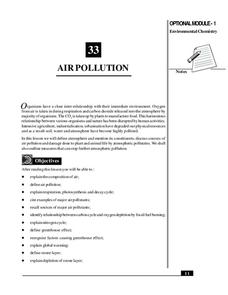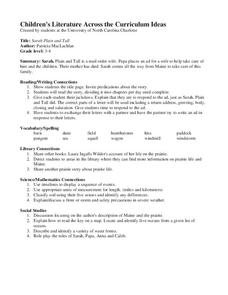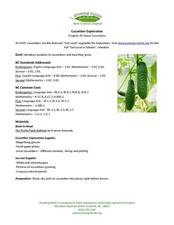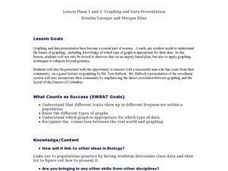Cornell University
Chemical Reactions
Investigate the Law of Conservation of Mass through a lab exploration. Individuals combine materials to initiate chemical reactions. They monitor for signs of reactions and measure the masses before and after the reactions for comparison.
Curated OER
The Life Cycle of a Butterfly
A well-designed instructional activity on the life cycle of the butterfly is here for you. In it, young scientists spend 45 minutes a day, for one school week, engaged in their study. They take nature walks, participate in activities in...
Curated OER
Knowing the Essential Elements of a Habitat
First graders compare their environment with that of Belize by researching via the internet on the sites provided. Students participate in various activities/centers utilizing the information they discovered.
Curated OER
A Cow's Life
Moo! An engaging two-part worksheet focuses on the role of cows in our agriculture system. The second part of the worksheet has ten discussion questions, which should lead to some interesting points about cows. Young farmers can learn...
ARKive
Penguin Diversity – Mask Making
Penguins are very diverse and well-adapted birds; they live on islands, in warm and cold climates. Little ones examine penguin diversity and discuss the highly functional adaptive traits that have helped them survive in some of the...
Environment Agency - Abu Dhabi
Sedimentation
Starting with a presentation, pupils learn about how sedimentary rocks form. They then create their own sedimentation bottle to observe the process.
American Chemical Society
The Ups and Downs of Thermometers
What has a thermometer earned that your pupils haven't? A degree! After reviewing the previous lessons about molecules and degrees, scholars observe how thermometers work before building their own. The module includes a activity sheet.
National Institute of Open Schooling
Air Pollution
Seventy percent of the air pollution in China is due to car exhaust. Under the umbrella of environmental chemistry, learners extensively explore air pollution. From the makeup of our atmosphere to sources of major air pollutants, classes...
National Institute of Open Schooling
Solid State
Crystal comes from a Greek word meaning ice. Activity eight in a series of 36 has class members analyzing amorphous and crystalline solids and further classifying them based on their forces. They then explore solids, learning about unit...
National Institute of Open Schooling
Adsorption and Catalysis
Adsorption, not absorption, is when atoms stick to the surface of an object, like water sticking to a grain of sand. An informative lesson delves into adsorption, teaching physical and chemisorption and the factors that affect them....
CK-12 Foundation
Energy Conservation Simulation
Does the amount of a roller coaster's energy change as it goes along the track? Scholars investigate when a roller coaster has potential and kinetic energy. They observe the changes as it goes up the initial hill follows it throughout...
University of Minnesota
Memory Box
Teachers encourage using memory tricks, but do they actually work? Scholars test word association in a short yet engaging activity. They use 10 seconds to memorize as many items as possible and determine if they are more successful if...
Curated OER
Sarah Plain and Tall
Students read the story, dividing it into chapters per day until complete. They respond to the ad, just as Sarah, Plain and Tall did and use the correct parts of a letter used including a return address, greeting, body, closing and...
Curated OER
Lesson Plan fo The Magic Eyes of Little Crab
Interested in a "how and why" story to read with young students? In this storytelling lesson, readers will discuss sea creatures, focusing on practicing new terminology through retelling the story. This resource provides a list of...
Curated OER
Children's Literature Across the Curriculum Ideas-If You Made A Million
Students read If You Made A Million by David M. Schwartz. They complete a variety of cross-curricular activities surrounding the study of earning, saving and spending money. Included are reading, art, math, science, writing, social...
Growing Minds
Growing Minds: Cucumber Exploration
After reading a picture book about planting and harvesting cucumbers, learners get a chance to examine some cucumbers of their own. First, they see photographs of a cucumber on a vine, and learn that it is part of the gourd family. They...
Curated OER
Graphing And Data Presentation
High schoolers engage in a study of science and mathematics with the practice of creating graphs. A guest speaker comes to the class to share statistics from the community and the students are shown how he uses the coordinate system in...
Curated OER
Sense of Hearing
Create a graphic organizer to review parts and systems of the body, then present a new topic. Special education students grades 3-5 learn about the sense of hearing. They draw parts of the ear, sign a song, read Perk Up Your Ears, and...
Curated OER
Medicine: Then and Now
Students read ancient Greek texts to explore ancient healing practices and compare them to those of modern times. They explain Greek healing practices for wounds.
Curated OER
Where Next?
Students read an article explaining NASA's possible Mars landing sites. They use the Internet to research Mars and the Module. They are able to submit their own proposals for a landing site after researching the planet.
Curated OER
Test-Tube Tissues
In this tissues worksheet, high schoolers read about a new treatment for fixing bone fractures. Students complete 4 short answer questions.
Curated OER
Physical and Chemical Changes
In this physical and chemical changes worksheet, students will read 4 different examples of a physical or chemical change and will write in the effect of each of these changes.
Curated OER
The Six Kingdoms
In this evolution worksheet, learners will determine the evolutionary relationships among organisms using cladograms and phylogenetic diagrams. This worksheet has 13 short answer questions and 3 multiple choice questions.
Curated OER
Invertebrates
For this invertebrate worksheet, students review characteristics of the different types of invertebrates. This worksheet places 32 vocabulary words into a crossword puzzle.

























